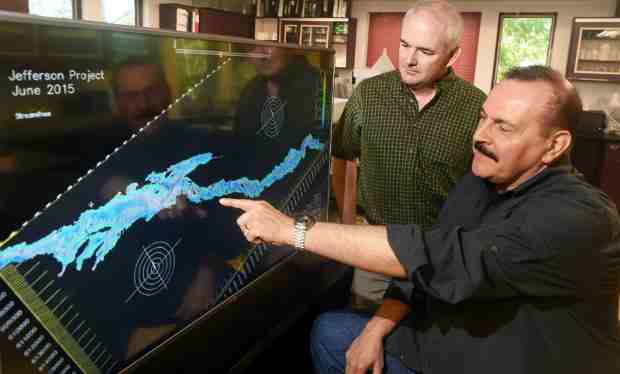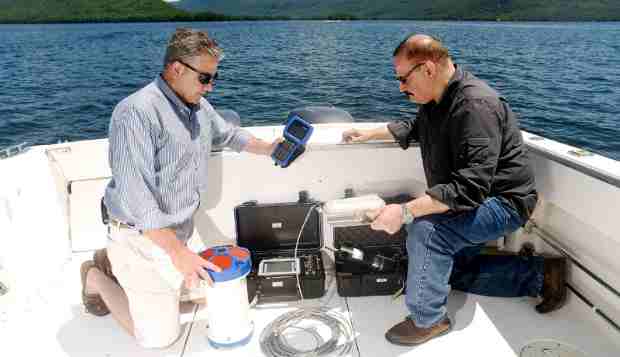Internet of Things to Protect New York’s Lake George

Jefferson Project Director Rick Relyea (left) and IBM Research Distinguished Engineer Harry Kolar (right) examine a visualization of Lake George, as part of The Jefferson Project at Lake George, a three year effort to deploy Internet of Things technology to create the “world’s smartest lake.”
The Jefferson Project at Lake George, one of the most ambitious research projects to deploy Big Data and analytics technology to manage and protect a body of fresh water, is entering a new phase.
Now enormous amounts of data will be captured from sensors and analyzed. Scientists anticipate that insights uncovered from the data collection and discovery stage of the project will not only help manage and protect one of America’s most famous lakes, but create a blueprint to preserve important lakes, rivers and other bodies of fresh water around the globe.
The potential impact of these new developments extends well beyond the shores of Lake George. By capturing and pooling data from all sorts of sensors and swiftly analyzing it, scientists, policy makers and environmental groups around the globe could soon accurately predict how weather, contaminants, invasive species and other threats might affect a lake’s natural environment.

IBM Research scientists Mike Kelly (left) and Harry Kolar (right) deploy an array of sensors that capture data which will be analyzed to help manage and protect New York’s Lake George. Their efforts are in support of The Jefferson Project at Lake George, a three year research initiative to deploy Internet of Things technology to create the “world’s smartest lake.”
Armed with these new insights and a growing body of best practices, corrective actions could be taken in advance to protect fresh water sources anywhere in the world.
A collaboration between IBM Research (NYSE: IBM), Rensselaer Polytechnic Institute and The FUND for Lake George, the Jefferson Project involves more than 60 scientists from around the world and IBM Research labs in Brazil, Ireland, Texas and New York.
The project is deploying Internet of Things technology on a grand scale in conjunction with research and experimentation to understand the ecology of large lakes and the impact of human activity.
Thirty-five years of monitoring the chemistry and algae in Lake George by scientists at Rensselaer’s Darrin Fresh Water Institute, in collaboration with The FUND for Lake George, have demonstrated the lake is changing.
Chloride inputs from road salt have tripled, algae have increased by one third, and five invasive species have been introduced. These factors threaten entire regional economies driven by water recreation, boating and other forms of tourism on fresh water lakes, rivers and streams.
The new phase of the project is the culmination of several milestones. An array of sophisticated sensors of different shapes and sizes, including underwater sonar based sensors; customized software programs and solar energy systems to power off-grid equipment have now been deployed, tested and refined.
These enhancements have led to greatly improved measurement data that will be used to better understand the lake and lead to improvements in the accuracy of four predictive models built by IBM researchers that precisely measure weather events, water run-off from the surrounding mountains into the lake, inputs of road salt to the lake, and water circulation.
The Jefferson Project is named after President Thomas Jefferson, who described Lake George as, “without comparison, the most beautiful water I ever saw.” The three-year initiative aims to establish one of the world’s most sophisticated lake environmental monitoring and prediction systems, giving scientists and the community a real-time picture of the health of the lake.
The project combines advanced data analytics, computing and data visualization techniques, new scientific and experimental methods, 3-D computer modeling and simulation, and historical data to gain an unprecedented scientific understanding of Lake George.
Photo / Video courtesy: IBM











